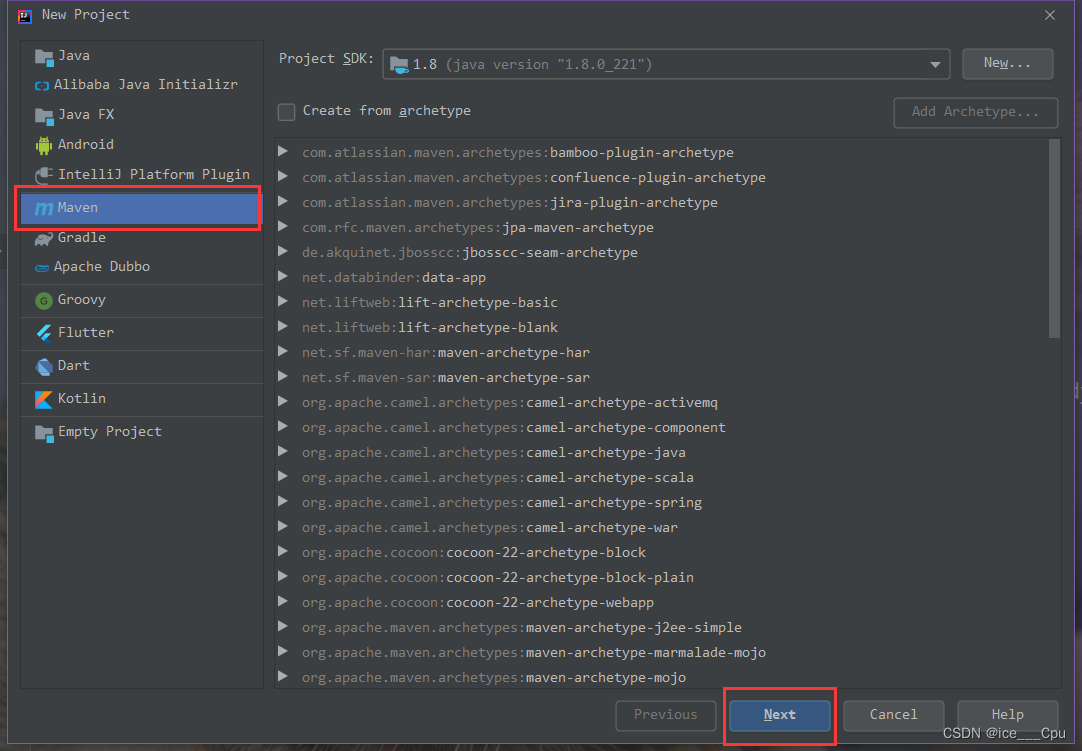1.什么是多级缓存
传统的缓存策略一般是请求到达Tomcat后,先查询Redis,如果未命中则查询数据库,如图:
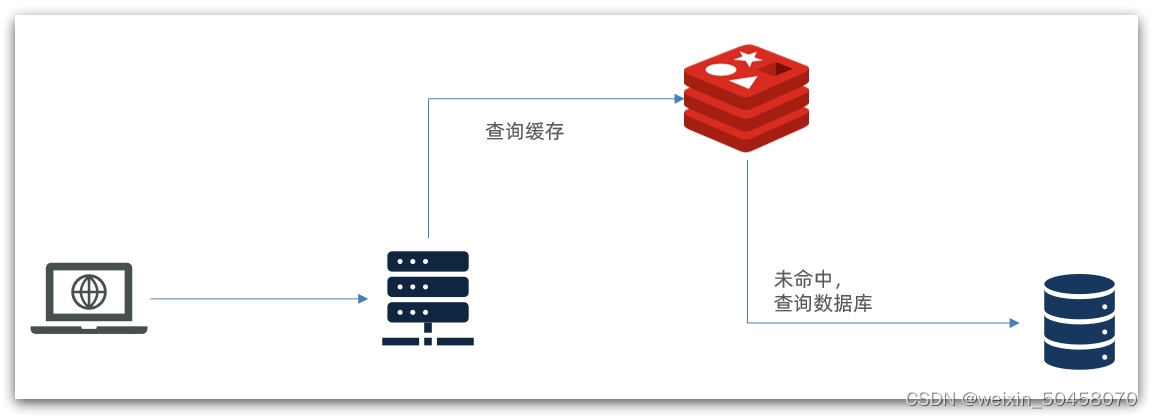
存在下面的问题:

在多级缓存架构中,Nginx内部需要编写本地缓存查询、Redis查询、Tomcat查询的业务逻辑,因此这样的nginx服务不再是一个反向代理服务器,而是一个编写业务的Web服务器了。
因此这样的业务Nginx服务也需要搭建集群来提高并发,再有专门的nginx服务来做反向代理,如图:
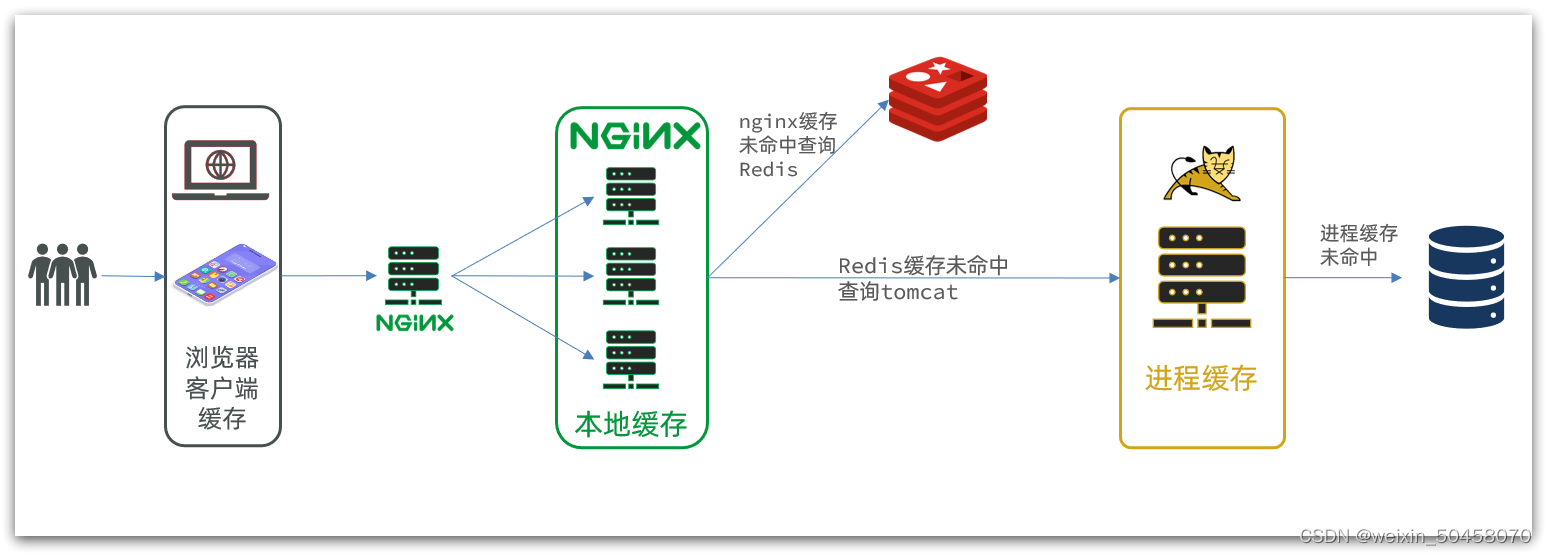

可见,多级缓存的关键有两个:
其中Nginx编程则会用到OpenResty框架结合Lua这样的语言。
2.JVM进程缓存
2.1.初识Caffeine
缓存在日常开发中启动至关重要的作用,由于是存储在内存中,数据的读取速度是非常快的,能大量减少对数据库的访问,减少数据库的压力。我们把缓存分为两类:
Caffeine是一个基于Java8开发的,提供了近乎最佳命中率的高性能的本地缓存库。目前Spring内部的缓存使用的就是Caffeine。
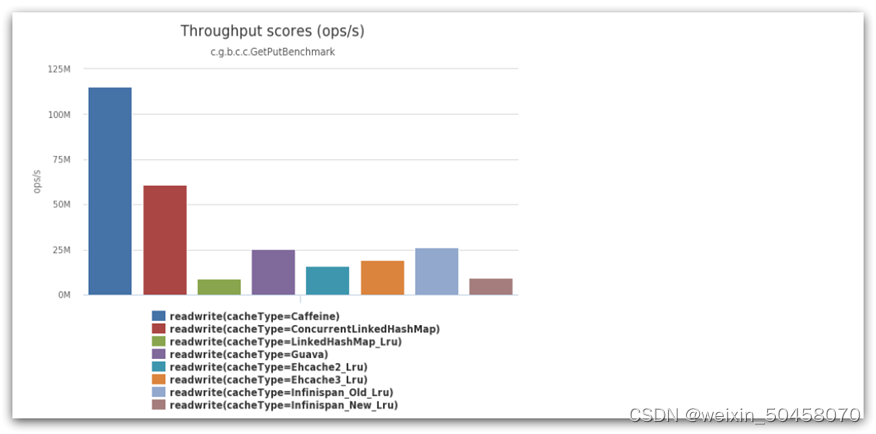
@Test
void testBasicOps() {
// 构建cache对象
Cache<String, String> cache = Caffeine.newBuilder().build();
// 存数据
cache.put("gf", "迪丽热巴");
// 取数据
String gf = cache.getIfPresent("gf");
System.out.println("gf = " + gf);
// 取数据,包含两个参数:
// 参数一:缓存的key
// 参数二:Lambda表达式,表达式参数就是缓存的key,方法体是查询数据库的逻辑
// 优先根据key查询JVM缓存,如果未命中,则执行参数二的Lambda表达式
String defaultGF = cache.get("defaultGF", key -> {
// 根据key去数据库查询数据
return "柳岩";
});
System.out.println("defaultGF = " + defaultGF);
}Caffeine既然是缓存的一种,肯定需要有缓存的清除策略,不然的话内存总会有耗尽的时候。
-
// 创建缓存对象 Cache<String, String> cache = Caffeine.newBuilder() .maximumSize(1) // 设置缓存大小上限为 1 .build(); -
// 创建缓存对象 Cache<String, String> cache = Caffeine.newBuilder() // 设置缓存有效期为 10 秒,从最后一次写入开始计时 .expireAfterWrite(Duration.ofSeconds(10)) .build();
注意:在默认情况下,当一个缓存元素过期的时候,Caffeine不会自动立即将其清理和驱逐。而是在一次读或写操作后,或者在空闲时间完成对失效数据的驱逐。
2.2.实现JVM进程缓存
2.2.1.需求
利用Caffeine实现下列需求:
2.2.2.实现
首先,我们需要定义两个Caffeine的缓存对象,分别保存商品、库存的缓存数据。
@Configuration
public class CaffeineConfig {
@Bean
public Cache<Long, Item> itemCache(){
return Caffeine.newBuilder()
.initialCapacity(100)
.maximumSize(10_000)
.build();
}
@Bean
public Cache<Long, ItemStock> stockCache(){
return Caffeine.newBuilder()
.initialCapacity(100)
.maximumSize(10_000)
.build();
}
}@RestController
@RequestMapping("item")
public class ItemController {
@Autowired
private IItemService itemService;
@Autowired
private IItemStockService stockService;
@Autowired
private Cache<Long, Item> itemCache;
@Autowired
private Cache<Long, ItemStock> stockCache;
// ...其它略
@GetMapping("/{id}")
public Item findById(@PathVariable("id") Long id) {
return itemCache.get(id, key -> itemService.query()
.ne("status", 3).eq("id", key)
.one()
);
}
@GetMapping("/stock/{id}")
public ItemStock findStockById(@PathVariable("id") Long id) {
return stockCache.get(id, key -> stockService.getById(key));
}
}3.Lua语法入门
Nginx编程需要用到Lua语言,因此我们必须先入门Lua的基本语法。
3.1.初识Lua
Lua 是一种轻量小巧的脚本语言,用标准C语言编写并以源代码形式开放, 其设计目的是为了嵌入应用程序中,从而为应用程序提供灵活的扩展和定制功能。官网:The Programming Language Lua

Lua经常嵌入到C语言开发的程序中,例如游戏开发、游戏插件等。
Nginx本身也是C语言开发,因此也允许基于Lua做拓展。
3.1.HelloWorld
CentOS7默认已经安装了Lua语言环境,所以可以直接运行Lua代码。
1)在Linux虚拟机的任意目录下,新建一个hello.lua文件

3)运行


3.2.变量和循环
学习任何语言必然离不开变量,而变量的声明必须先知道数据的类型。
3.2.1.Lua的数据类型

另外,Lua提供了type()函数来判断一个变量的数据类型:

3.2.2.声明变量
Lua声明变量的时候无需指定数据类型,而是用local来声明变量为局部变量:
local str2 = ‘hello’ .. ‘world’
— 声明数字
— 声明布尔类型
Lua中的table类型既可以作为数组,又可以作为Java中的map来使用。数组就是特殊的table,key是数组角标而已:
Lua中的table可以用key来访问:
— 访问table
print(map[‘name‘])
print(map.name)
3.2.3.循环
对于table,我们可以利用for循环来遍历。不过数组和普通table遍历略有差异。
— 声明数组 key为索引的 table 数组——ipairs
local arr = {‘java‘, ‘python‘, ‘lua’}
— 遍历数组
遍历普通table
— 声明map,也就是table map-pairs
local map = {name=’Jack‘, age=21}
— 遍历table
for key,value in pairs(map) do
print(key, value)
end


3.3.条件控制、函数
3.3.1.函数
function 函数名( argument1, argument2…, argumentn)
— 函数体
return 返回值
end
function printArr(arr)
for index, value in ipairs(arr) do
print(value)
end
end
3.3.2.条件控制
if(布尔表达式)
then
–[ 布尔表达式为 true 时执行该语句块 –]
else
–[ 布尔表达式为 false 时执行该语句块 –]
end

3.3.3.案例
需求:自定义一个函数,可以打印table,当参数为nil时,打印错误信息
function printArr(arr)
if not arr then
print(‘数组不能为空!’)
end
for index, value in ipairs(arr) do
print(value)
end
end
4.实现多级缓存
多级缓存的实现离不开Nginx编程,而Nginx编程又离不开OpenResty。
4.1.安装OpenResty
OpenResty® 是一个基于 Nginx的高性能 Web 平台,用于方便地搭建能够处理超高并发、扩展性极高的动态 Web 应用、Web 服务和动态网关。具备下列特点:


4.2.OpenResty快速入门

其中:
4.2.1.反向代理流程
现在,商品详情页使用的是假的商品数据。不过在浏览器中,可以看到页面有发起ajax请求查询真实商品数据。
这个请求如下:

请求地址是localhost,端口是80,就被windows上安装的Nginx服务给接收到了。然后代理给了OpenResty集群:

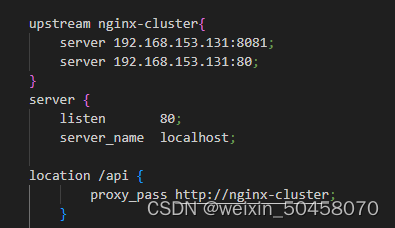
我们需要在OpenResty中编写业务,查询商品数据并返回到浏览器。
但是这次,我们先在OpenResty接收请求,返回假的商品数据。
4.2.2.OpenResty监听请求
OpenResty的很多功能都依赖于其目录下的Lua库,需要在nginx.conf中指定依赖库的目录,并导入依赖:
修改/usr/local/openresty/nginx/conf/nginx.conf文件,在其中的http下面,添加下面代码:
#lua 模块 lua_package_path "/usr/local/openresty/lualib/?.lua;;"; #c模块 lua_package_cpath "/usr/local/openresty/lualib/?.so;;";
修改/usr/local/openresty/nginx/conf/nginx.conf文件,在nginx.conf的server下面,添加对/api/item这个路径的监听:
location /api/item { # 默认的响应类型 default_type application/json; # 响应结果由lua/item.lua文件来决定 content_by_lua_file lua/item.lua; }

这个监听,就类似于SpringMVC中的@GetMapping("/api/item")做路径映射。
而content_by_lua_file lua/item.lua则相当于调用item.lua这个文件,执行其中的业务,把结果返回给用户。相当于java中调用service。
书写时注意:可以将这些内容复制到vscode内查看是否有多余空格,有多余空格则需要去除要不然运行nginx -s reload时会报错
4.2.3.编写item.lua
1)在/usr/loca/openresty/nginx目录创建文件夹:lua

2)在/usr/loca/openresty/nginx/lua文件夹下,新建文件:item.lua

3)编写item.lua,返回假数据
item.lua中,利用ngx.say()函数返回数据到Response中
ngx.say('{"id":10001,"name":"SALSA AIR","title":"RIMOWA 21寸托运箱拉杆箱 SALSA AIR系列果绿色 820.70.36.4","price":17900,"image":"https://m.360buyimg.com/mobilecms/s720x720_jfs/t6934/364/1195375010/84676/e9f2c55f/597ece38N0ddcbc77.jpg!q70.jpg.webp","category":"拉杆箱","brand":"RIMOWA","spec":"","status":1,"createTime":"2019-04-30T16:00:00.000+00:00","updateTime":"2019-04-30T16:00:00.000+00:00","stock":2999,"sold":31290}')nginx -s reload
刷新商品页面:http://localhost/item.html?id=10001,即可看到效果:

4.3.请求参数处理
上一节中,我们在OpenResty接收前端请求,但是返回的是假数据。
要返回真实数据,必须根据前端传递来的商品id,查询商品信息才可以。
4.3.1.获取参数的API
OpenResty中提供了一些API用来获取不同类型的前端请求参数:

4.3.2.获取参数并返回

可以看到商品id是以路径占位符方式传递的,因此可以利用正则表达式匹配的方式来获取ID
1)获取商品id
修改/usr/loca/openresty/nginx/nginx.conf文件中监听/api/item的代码,利用正则表达式获取ID:
location ~ /api/item/(d+) { # 默认的响应类型 default_type application/json; # 响应结果由lua/item.lua文件来决定 content_by_lua_file lua/item.lua; }
修改/usr/loca/openresty/nginx/lua/item.lua文件,获取id并拼接到结果中返回:
-- 获取商品id local id = ngx.var[1] -- 拼接并返回 ngx.say('{"id":' .. id .. ',"name":"SALSA AIR","title":"RIMOWA 21寸托运箱拉杆箱 SALSA AIR系列果绿色 820.70.36.4","price":17900,"image":"https://m.360buyimg.com/mobilecms/s720x720_jfs/t6934/364/1195375010/84676/e9f2c55f/597ece38N0ddcbc77.jpg!q70.jpg.webp","category":"拉杆箱","brand":"RIMOWA","spec":"","status":1,"createTime":"2019-04-30T16:00:00.000+00:00","updateTime":"2019-04-30T16:00:00.000+00:00","stock":2999,"sold":31290}')
nginx -s reload
刷新页面可以看到结果中已经带上了ID:

4.4.查询Tomcat
拿到商品ID后,本应去缓存中查询商品信息,不过目前我们还未建立nginx、redis缓存。因此,这里我们先根据商品id去tomcat查询商品信息。我们实现如图部分:

需要注意的是,我们的OpenResty是在虚拟机,Tomcat是在Windows电脑上。两者IP一定不要搞错了。

4.4.1.发送http请求的API
local resp = ngx.location.capture("/path",{ method = ngx.HTTP_GET, -- 请求方式 args = {a=1,b=2}, -- get方式传参数 })
注意:这里的path是路径,并不包含IP和端口。这个请求会被nginx内部的server监听并处理。
但是我们希望这个请求发送到Tomcat服务器,所以还需要编写一个server来对这个路径做反向代理:
location /path { # 这里是windows电脑的ip和Java服务端口,需要确保windows防火墙处于关闭状态 proxy_pass http://192.168.150.1:8081; }
原理如图:

4.4.2.封装http工具
下面,我们封装一个发送Http请求的工具,基于ngx.location.capture来实现查询tomcat。
因为item-service中的接口都是/item开头,所以我们监听/item路径,代理到windows上的tomcat服务。
修改 /usr/local/openresty/nginx/conf/nginx.conf文件,添加一个location:
location /item { proxy_pass http://192.168.150.1:8081; }
以后,只要我们调用ngx.location.capture("/item"),就一定能发送请求到windows的tomcat服务。
之前我们说过,OpenResty启动时会加载以下两个目录中的工具文件:

所以,自定义的http工具也需要放到这个目录下。
在/usr/local/openresty/lualib目录下,新建一个common.lua文件:
vi /usr/local/openresty/lualib/common.lua
内容如下:
-- 封装函数,发送http请求,并解析响应 local function read_http(path, params) local resp = ngx.location.capture(path,{ method = ngx.HTTP_GET, args = params, }) if not resp then -- 记录错误信息,返回404 ngx.log(ngx.ERR, "http请求查询失败, path: ", path , ", args: ", args) ngx.exit(404) end return resp.body end -- 将方法导出 local _M = { read_http = read_http } return _M
这个工具将read_http函数封装到_M这个table类型的变量中,并且返回,这类似于导出。
使用的时候,可以利用require('common')来导入该函数库,这里的common是函数库的文件名。
3)实现商品查询
最后,我们修改/usr/local/openresty/lua/item.lua文件,利用刚刚封装的函数库实现对tomcat的查询:
-- 引入自定义common工具模块,返回值是common中返回的 _M local common = require("common") -- 从 common中获取read_http这个函数 local read_http = common.read_http -- 获取路径参数 local id = ngx.var[1] -- 根据id查询商品 local itemJSON = read_http("/item/".. id, nil) -- 根据id查询商品库存 local itemStockJSON = read_http("/item/stock/".. id, nil)
这里查询到的结果是json字符串,并且包含商品、库存两个json字符串,页面最终需要的是把两个json拼接为一个json:

这就需要我们先把JSON变为lua的table,完成数据整合后,再转为JSON。
4.4.3.CJSON工具类
OpenResty提供了一个cjson的模块用来处理JSON的序列化和反序列化。
官方地址: GitHub – openresty/lua-cjson: Lua CJSON is a fast JSON encoding/parsing module for Lua
local cjson = require "cjson"
2)序列化:
local obj = { name = 'jack', age = 21 } -- 把 table 序列化为 json local json = cjson.encode(obj)
3)反序列化:
local json = '{"name": "jack", "age": 21}'
-- 反序列化 json为 table
local obj = cjson.decode(json);
print(obj.name)
4.4.4.实现Tomcat查询
下面,我们修改之前的item.lua中的业务,添加json处理功能:
-- 导入common函数库 local common = require('common') local read_http = common.read_http -- 导入cjson库 local cjson = require('cjson') -- 获取路径参数 local id = ngx.var[1] -- 根据id查询商品 local itemJSON = read_http("/item/".. id, nil) -- 根据id查询商品库存 local itemStockJSON = read_http("/item/stock/".. id, nil) -- JSON转化为lua的table local item = cjson.decode(itemJSON) local stock = cjson.decode(stockJSON) -- 组合数据 item.stock = stock.stock item.sold = stock.sold -- 把item序列化为json 返回结果 ngx.say(cjson.encode(item))
4.4.5.基于ID负载均衡
刚才的代码中,我们的tomcat是单机部署。而实际开发中,tomcat一定是集群模式:

而默认的负载均衡规则是轮询模式,当我们查询/item/10001时:
你看,因为轮询的原因,第一次查询8081形成的JVM缓存并未生效,直到下一次再次访问到8081时才可以生效,缓存命中率太低了。
怎么办?
如果能让同一个商品,每次查询时都访问同一个tomcat服务,那么JVM缓存就一定能生效了。
也就是说,我们需要根据商品id做负载均衡,而不是轮询。
1)原理
nginx提供了基于请求路径做负载均衡的算法:
nginx根据请求路径做hash运算,把得到的数值对tomcat服务的数量取余,余数是几,就访问第几个服务,实现负载均衡。
例如:
只要id不变,每次hash运算结果也不会变,那就可以保证同一个商品,一直访问同一个tomcat服务,确保JVM缓存生效。
2)实现
修改/usr/local/openresty/nginx/conf/nginx.conf文件,实现基于ID做负载均衡。
首先,定义tomcat集群,并设置基于路径做负载均衡:
upstream tomcat-cluster { hash $request_uri; server 192.168.150.1:8081; server 192.168.150.1:8082; }
然后,修改对tomcat服务的反向代理,目标指向tomcat集群:
location /item {
proxy_pass http://tomcat-cluster;
}
重新加载OpenResty
nginx -s reload
3)测试
启动两台tomcat服务:

同时启动:

清空日志后,再次访问页面,可以看到不同id的商品,访问到了不同的tomcat服务:


4.5.Redis缓存预热
Redis缓存会面临冷启动问题:
冷启动:服务刚刚启动时,Redis中并没有缓存,如果所有商品数据都在第一次查询时添加缓存,可能会给数据库带来较大压力。
缓存预热:在实际开发中,我们可以利用大数据统计用户访问的热点数据,在项目启动时将这些热点数据提前查询并保存到Redis中。
我们数据量较少,并且没有数据统计相关功能,目前可以在启动时将所有数据都放入缓存中。
1)利用Docker安装Redis
docker run --name redis -p 6379:6379 -d redis redis-server --appendonly yes
<dependency> <groupId>org.springframework.boot</groupId> <artifactId>spring-boot-starter-data-redis</artifactId> </dependency>
3)配置Redis地址
spring: redis: host: 192.168.150.101
4)编写初始化类
缓存预热需要在项目启动时完成,并且必须是拿到RedisTemplate之后。
这里我们利用InitializingBean接口来实现,因为InitializingBean可以在对象被Spring创建并且成员变量全部注入后执行。
package com.heima.item.config; import com.fasterxml.jackson.core.JsonProcessingException; import com.fasterxml.jackson.databind.ObjectMapper; import com.heima.item.pojo.Item; import com.heima.item.pojo.ItemStock; import com.heima.item.service.IItemService; import com.heima.item.service.IItemStockService; import org.springframework.beans.factory.InitializingBean; import org.springframework.beans.factory.annotation.Autowired; import org.springframework.data.redis.core.StringRedisTemplate; import org.springframework.stereotype.Component; import java.util.List; @Component public class RedisHandler implements InitializingBean { @Autowired private StringRedisTemplate redisTemplate; @Autowired private IItemService itemService; @Autowired private IItemStockService stockService; private static final ObjectMapper MAPPER = new ObjectMapper(); @Override public void afterPropertiesSet() throws Exception { // 初始化缓存 // 1.查询商品信息 List<Item> itemList = itemService.list(); // 2.放入缓存 for (Item item : itemList) { // 2.1.item序列化为JSON String json = MAPPER.writeValueAsString(item); // 2.2.存入redis redisTemplate.opsForValue().set("item:id:" + item.getId(), json); } // 3.查询商品库存信息 List<ItemStock> stockList = stockService.list(); // 4.放入缓存 for (ItemStock stock : stockList) { // 2.1.item序列化为JSON String json = MAPPER.writeValueAsString(stock); // 2.2.存入redis redisTemplate.opsForValue().set("item:stock:id:" + stock.getId(), json); } } }
4.6.查询Redis缓存
现在,Redis缓存已经准备就绪,我们可以再OpenResty中实现查询Redis的逻辑了。如下图红框所示:

当请求进入OpenResty之后:
-
优先查询Redis缓存
-
如果Redis缓存未命中,再查询Tomcat
4.6.1.封装Redis工具
OpenResty提供了操作Redis的模块,我们只要引入该模块就能直接使用。但是为了方便,我们将Redis操作封装到之前的common.lua工具库中。
修改/usr/local/openresty/lualib/common.lua文件:
-- 导入redis
local redis = require('resty.redis')
-- 初始化redis
local red = redis:new()
red:set_timeouts(1000, 1000, 1000)
-- 关闭redis连接的工具方法,其实是放入连接池 local function close_redis(red) local pool_max_idle_time = 10000 -- 连接的空闲时间,单位是毫秒 local pool_size = 100 --连接池大小 local ok, err = red:set_keepalive(pool_max_idle_time, pool_size) if not ok then ngx.log(ngx.ERR, "放入redis连接池失败: ", err) end end
3)封装函数,根据key查询Redis数据
-- 查询redis的方法 ip和port是redis地址,key是查询的key local function read_redis(ip, port, key) -- 获取一个连接 local ok, err = red:connect(ip, port) if not ok then ngx.log(ngx.ERR, "连接redis失败 : ", err) return nil end -- 查询redis local resp, err = red:get(key) -- 查询失败处理 if not resp then ngx.log(ngx.ERR, "查询Redis失败: ", err, ", key = " , key) end --得到的数据为空处理 if resp == ngx.null then resp = nil ngx.log(ngx.ERR, "查询Redis数据为空, key = ", key) end close_redis(red) return resp end
4)导出
-- 将方法导出 local _M = { read_http = read_http, read_redis = read_redis } return _M
完整的common.lua:
-- 导入redis
local redis = require('resty.redis')
-- 初始化redis
local red = redis:new()
red:set_timeouts(1000, 1000, 1000)
-- 关闭redis连接的工具方法,其实是放入连接池
local function close_redis(red)
local pool_max_idle_time = 10000 -- 连接的空闲时间,单位是毫秒
local pool_size = 100 --连接池大小
local ok, err = red:set_keepalive(pool_max_idle_time, pool_size)
if not ok then
ngx.log(ngx.ERR, "放入redis连接池失败: ", err)
end
end
-- 查询redis的方法 ip和port是redis地址,key是查询的key
local function read_redis(ip, port, key)
-- 获取一个连接
local ok, err = red:connect(ip, port)
if not ok then
ngx.log(ngx.ERR, "连接redis失败 : ", err)
return nil
end
-- 查询redis
local resp, err = red:get(key)
-- 查询失败处理
if not resp then
ngx.log(ngx.ERR, "查询Redis失败: ", err, ", key = " , key)
end
--得到的数据为空处理
if resp == ngx.null then
resp = nil
ngx.log(ngx.ERR, "查询Redis数据为空, key = ", key)
end
close_redis(red)
return resp
end
-- 封装函数,发送http请求,并解析响应
local function read_http(path, params)
local resp = ngx.location.capture(path,{
method = ngx.HTTP_GET,
args = params,
})
if not resp then
-- 记录错误信息,返回404
ngx.log(ngx.ERR, "http查询失败, path: ", path , ", args: ", args)
ngx.exit(404)
end
return resp.body
end
-- 将方法导出
local _M = {
read_http = read_http,
read_redis = read_redis
}
return _M
4.6.2.实现Redis查询
接下来,我们就可以去修改item.lua文件,实现对Redis的查询了。
查询逻辑是:
-
根据id查询Redis
-
如果查询失败则继续查询Tomcat
-
将查询结果返回
1)修改/usr/local/openresty/lua/item.lua文件,添加一个查询函数:
-- 导入common函数库
local common = require('common')
local read_http = common.read_http
local read_redis = common.read_redis
-- 封装查询函数
function read_data(key, path, params)
-- 查询本地缓存
local val = read_redis("127.0.0.1", 6379, key)
-- 判断查询结果
if not val then
ngx.log(ngx.ERR, "redis查询失败,尝试查询http, key: ", key)
-- redis查询失败,去查询http
val = read_http(path, params)
end
-- 返回数据
return val
end
2)而后修改商品查询、库存查询的业务:

3)完整的item.lua代码:
-- 导入common函数库
local common = require('common')
local read_http = common.read_http
local read_redis = common.read_redis
-- 导入cjson库
local cjson = require('cjson')
-- 封装查询函数
function read_data(key, path, params)
-- 查询本地缓存
local val = read_redis("127.0.0.1", 6379, key)
-- 判断查询结果
if not val then
ngx.log(ngx.ERR, "redis查询失败,尝试查询http, key: ", key)
-- redis查询失败,去查询http
val = read_http(path, params)
end
-- 返回数据
return val
end
-- 获取路径参数
local id = ngx.var[1]
-- 查询商品信息
local itemJSON = read_data("item:id:" .. id, "/item/" .. id, nil)
-- 查询库存信息
local stockJSON = read_data("item:stock:id:" .. id, "/item/stock/" .. id, nil)
-- JSON转化为lua的table
local item = cjson.decode(itemJSON)
local stock = cjson.decode(stockJSON)
-- 组合数据
item.stock = stock.stock
item.sold = stock.sold
-- 把item序列化为json 返回结果
ngx.say(cjson.encode(item))
4.7.Nginx本地缓存
现在,整个多级缓存中只差最后一环,也就是nginx的本地缓存了。如图:

4.7.1.本地缓存API
OpenResty为Nginx提供了shard dict的功能,可以在nginx的多个worker之间共享数据,实现缓存功能。
1)开启共享字典,在nginx.conf的http下添加配置:
# 共享字典,也就是本地缓存,名称叫做:item_cache,大小150m lua_shared_dict item_cache 150m;
2)操作共享字典:
-- 获取本地缓存对象 local item_cache = ngx.shared.item_cache -- 存储, 指定key、value、过期时间,单位s,默认为0代表永不过期 item_cache:set('key', 'value', 1000) -- 读取 local val = item_cache:get('key')
4.7.2.实现本地缓存查询
1)修改/usr/local/openresty/lua/item.lua文件,修改read_data查询函数,添加本地缓存逻辑:
-- 导入共享词典,本地缓存 local item_cache = ngx.shared.item_cache -- 封装查询函数 function read_data(key, expire, path, params) -- 查询本地缓存 local val = item_cache:get(key) if not val then ngx.log(ngx.ERR, "本地缓存查询失败,尝试查询Redis, key: ", key) -- 查询redis val = read_redis("127.0.0.1", 6379, key) -- 判断查询结果 if not val then ngx.log(ngx.ERR, "redis查询失败,尝试查询http, key: ", key) -- redis查询失败,去查询http val = read_http(path, params) end end -- 查询成功,把数据写入本地缓存 item_cache:set(key, val, expire) -- 返回数据 return val end
2)修改item.lua中查询商品和库存的业务,实现最新的read_data函数:

其实就是多了缓存时间参数,过期后nginx缓存会自动删除,下次访问即可更新缓存。
因为库存更新频率较高,如果缓存时间过长,可能与数据库差异较大。
3)完整的item.lua文件:
-- 导入common函数库
local common = require('common')
local read_http = common.read_http
local read_redis = common.read_redis
-- 导入cjson库
local cjson = require('cjson')
-- 导入共享词典,本地缓存
local item_cache = ngx.shared.item_cache
-- 封装查询函数
function read_data(key, expire, path, params)
-- 查询本地缓存
local val = item_cache:get(key)
if not val then
ngx.log(ngx.ERR, "本地缓存查询失败,尝试查询Redis, key: ", key)
-- 查询redis
val = read_redis("127.0.0.1", 6379, key)
-- 判断查询结果
if not val then
ngx.log(ngx.ERR, "redis查询失败,尝试查询http, key: ", key)
-- redis查询失败,去查询http
val = read_http(path, params)
end
end
-- 查询成功,把数据写入本地缓存
item_cache:set(key, val, expire)
-- 返回数据
return val
end
-- 获取路径参数
local id = ngx.var[1]
-- 查询商品信息
local itemJSON = read_data("item:id:" .. id, 1800, "/item/" .. id, nil)
-- 查询库存信息
local stockJSON = read_data("item:stock:id:" .. id, 60, "/item/stock/" .. id, nil)
-- JSON转化为lua的table
local item = cjson.decode(itemJSON)
local stock = cjson.decode(stockJSON)
-- 组合数据
item.stock = stock.stock
item.sold = stock.sold
-- 把item序列化为json 返回结果
ngx.say(cjson.encode(item))
5.缓存同步
大多数情况下,浏览器查询到的都是缓存数据,如果缓存数据与数据库数据存在较大差异,可能会产生比较严重的后果。
所以我们必须保证数据库数据、缓存数据的一致性,这就是缓存与数据库的同步。
5.1.数据同步策略
设置有效期:给缓存设置有效期,到期后自动删除。再次查询时更新
同步双写:在修改数据库的同时,直接修改缓存
异步通知:修改数据库时发送事件通知,相关服务监听到通知后修改缓存数据
-
优势:低耦合,可以同时通知多个缓存服务
-
缺点:时效性一般,可能存在中间不一致状态
-
场景:时效性要求一般,有多个服务需要同步
而异步实现又可以基于MQ或者Canal来实现:
1)基于MQ的异步通知:

解读:
依然有少量的代码侵入。
2)基于Canal的通知

解读:
代码零侵入
5.2.安装Canal
5.2.1.认识Canal
Canal [kə’næl],译意为水道/管道/沟渠,canal是阿里巴巴旗下的一款开源项目,基于Java开发。基于数据库增量日志解析,提供增量数据订阅&消费。GitHub的地址:GitHub – alibaba/canal: 阿里巴巴 MySQL binlog 增量订阅&消费组件
Canal是基于mysql的主从同步来实现的,MySQL主从同步的原理如下:

-
1)MySQL master 将数据变更写入二进制日志( binary log),其中记录的数据叫做binary log events
-
2)MySQL slave 将 master 的 binary log events拷贝到它的中继日志(relay log)
-
3)MySQL slave 重放 relay log 中事件,将数据变更反映它自己的数据
而Canal就是把自己伪装成MySQL的一个slave节点,从而监听master的binary log变化。再把得到的变化信息通知给Canal的客户端,进而完成对其它数据库的同步。

5.2.2.安装Canal

5.3.监听Canal
Canal提供了各种语言的客户端,当Canal监听到binlog变化时,会通知Canal的客户端。

我们可以利用Canal提供的Java客户端,监听Canal通知消息。当收到变化的消息时,完成对缓存的更新。
不过这里我们会使用GitHub上的第三方开源的canal-starter客户端。地址:GitHub – NormanGyllenhaal/canal-client: spring boot canal starter 易用的canal 客户端 canal client
与SpringBoot完美整合,自动装配,比官方客户端要简单好用很多。
5.3.1.引入依赖:
<dependency> <groupId>top.javatool</groupId> <artifactId>canal-spring-boot-starter</artifactId> <version>1.2.1-RELEASE</version> </dependency>
5.3.2.编写配置:
canal: destination: heima # canal的集群名字,要与安装canal时设置的名称一致 server: 192.168.150.101:11111 # canal服务地址
5.3.3.修改Item实体类
通过@Id、@Column、等注解完成Item与数据库表字段的映射:
package com.heima.item.pojo; import com.baomidou.mybatisplus.annotation.IdType; import com.baomidou.mybatisplus.annotation.TableField; import com.baomidou.mybatisplus.annotation.TableId; import com.baomidou.mybatisplus.annotation.TableName; import lombok.Data; import org.springframework.data.annotation.Id; import org.springframework.data.annotation.Transient; import javax.persistence.Column; import java.util.Date; @Data @TableName("tb_item") public class Item { @TableId(type = IdType.AUTO) @Id private Long id;//商品id @Column(name = "name") private String name;//商品名称 private String title;//商品标题 private Long price;//价格(分) private String image;//商品图片 private String category;//分类名称 private String brand;//品牌名称 private String spec;//规格 private Integer status;//商品状态 1-正常,2-下架 private Date createTime;//创建时间 private Date updateTime;//更新时间 @TableField(exist = false) @Transient private Integer stock; @TableField(exist = false) @Transient private Integer sold; }
5.3.4.编写监听器
通过实现EntryHandler<T>接口编写监听器,监听Canal消息。注意两点:
package com.heima.item.canal; import com.github.benmanes.caffeine.cache.Cache; import com.heima.item.config.RedisHandler; import com.heima.item.pojo.Item; import org.springframework.beans.factory.annotation.Autowired; import org.springframework.stereotype.Component; import top.javatool.canal.client.annotation.CanalTable; import top.javatool.canal.client.handler.EntryHandler; @CanalTable("tb_item") @Component public class ItemHandler implements EntryHandler<Item> { @Autowired private RedisHandler redisHandler; @Autowired private Cache<Long, Item> itemCache; @Override public void insert(Item item) { // 写数据到JVM进程缓存 itemCache.put(item.getId(), item); // 写数据到redis redisHandler.saveItem(item); } @Override public void update(Item before, Item after) { // 写数据到JVM进程缓存 itemCache.put(after.getId(), after); // 写数据到redis redisHandler.saveItem(after); } @Override public void delete(Item item) { // 删除数据到JVM进程缓存 itemCache.invalidate(item.getId()); // 删除数据到redis redisHandler.deleteItemById(item.getId()); } }
在这里对Redis的操作都封装到了RedisHandler这个对象中,是我们之前做缓存预热时编写的一个类,内容如下:
package com.heima.item.config; import com.fasterxml.jackson.core.JsonProcessingException; import com.fasterxml.jackson.databind.ObjectMapper; import com.heima.item.pojo.Item; import com.heima.item.pojo.ItemStock; import com.heima.item.service.IItemService; import com.heima.item.service.IItemStockService; import org.springframework.beans.factory.InitializingBean; import org.springframework.beans.factory.annotation.Autowired; import org.springframework.data.redis.core.StringRedisTemplate; import org.springframework.stereotype.Component; import java.util.List; @Component public class RedisHandler implements InitializingBean { @Autowired private StringRedisTemplate redisTemplate; @Autowired private IItemService itemService; @Autowired private IItemStockService stockService; private static final ObjectMapper MAPPER = new ObjectMapper(); @Override public void afterPropertiesSet() throws Exception { // 初始化缓存 // 1.查询商品信息 List<Item> itemList = itemService.list(); // 2.放入缓存 for (Item item : itemList) { // 2.1.item序列化为JSON String json = MAPPER.writeValueAsString(item); // 2.2.存入redis redisTemplate.opsForValue().set("item:id:" + item.getId(), json); } // 3.查询商品库存信息 List<ItemStock> stockList = stockService.list(); // 4.放入缓存 for (ItemStock stock : stockList) { // 2.1.item序列化为JSON String json = MAPPER.writeValueAsString(stock); // 2.2.存入redis redisTemplate.opsForValue().set("item:stock:id:" + stock.getId(), json); } } public void saveItem(Item item) { try { String json = MAPPER.writeValueAsString(item); redisTemplate.opsForValue().set("item:id:" + item.getId(), json); } catch (JsonProcessingException e) { throw new RuntimeException(e); } } public void deleteItemById(Long id) { redisTemplate.delete("item:id:" + id); } }
原文地址:https://blog.csdn.net/weixin_50458070/article/details/134697520
本文来自互联网用户投稿,该文观点仅代表作者本人,不代表本站立场。本站仅提供信息存储空间服务,不拥有所有权,不承担相关法律责任。
如若转载,请注明出处:http://www.7code.cn/show_9457.html
如若内容造成侵权/违法违规/事实不符,请联系代码007邮箱:suwngjj01@126.com进行投诉反馈,一经查实,立即删除!



